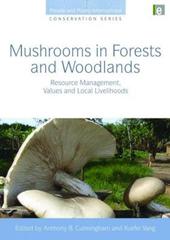
|
Mushrooms in Forests and Woodlands: Resource Management, Values and Local Livelihoods
Hardback
Main Details
| Title |
Mushrooms in Forests and Woodlands: Resource Management, Values and Local Livelihoods
|
| Authors and Contributors |
By (author) Xuefei Yang
|
|
Edited by Anthony B. Cunningham
|
|
Edited by Xuefei Yang
|
| Series | People and Plants International Conservation |
|---|
| Physical Properties |
| Format:Hardback | | Pages:240 | | Dimensions(mm): Height 240,Width 170 |
|
| Category/Genre | Management of land and natural resources |
|---|
| ISBN/Barcode |
9781849711395
|
| Classifications | Dewey:333.953 |
|---|
| Audience | | Tertiary Education (US: College) | | Professional & Vocational | |
|---|
| Illustrations |
Photographs, figures, tables, boxes, index
|
|
Publishing Details |
| Publisher |
Taylor & Francis Ltd
|
| Imprint |
Earthscan Ltd
|
| Publication Date |
19 November 2010 |
| Publication Country |
United Kingdom
|
Description
Many mushrooms - or the 'fruits of fungi' - are extremely valuable, wild-gathered products which are utilised for both their medicinal properties and as food. In many of the world's tropical and temperate forests, they are the primary source of income for the people who live there. These forests range from temperate woodlands and small forests to high altitude forests in the Himalaya and tropical miombo woodlands in south-central Africa. In south-west China, over 200 species of wild fungi in 64 genera are commercially traded while in Europe and North America, woodlands and small forests are the source of many highly-prized mushrooms and an essential resource for many small enterprises and collectors. Yet the increased demand for timber has resulted in the rapid expansion of forestry, which in turn has destroyed the natural habitat of many fungi, unbalancing both forest economics and ecology. Despite the economic, social and cultural values of fungi, there is a general lack of understanding of their importance to local livelihoods and forest ecology. This book aims to fill this gap and extends the People and Plants Conservation Series beyond the plant kingdom into the related world of fungi and mushrooms. It demonstrates the crucial roles that fungi play in maintaining forest ecosystems and the livelihoods of rural people throughout the world while providing good practice guidelines for the sustainable management of this resource and an assessment of economic value. It brings together the perspectives of biologists, anthropologists and forest and woodland managers to provide a unique inter-disciplinary and international overview of the key issues.
Author Biography
Dr A B (Tony) Cunningham works with People and Plants International (PPI), is a Senior Associate at CIFOR and an Adjunct Professor at the School of Plant Biology, University of Western Australia. He is an ethnoecologist/applied ecologist who has focussed on the interface between local livelihoods, sustainable natural resource use and conservation. He has written many peer reviewed publications, including the book 'Applied ethnobotany: people, wild plant use and conservation' (Earthscan, 2001) and has been the recipient of several awards, including the Sir Peter Scott Conservation award (1999) from IUCN and the E K Janakki medal (2003) for services to the field of ethnobotany. Dr Xuefei Yang did her first MSc on forests and land-use changes in Yunnan, China (2001) and then worked extensively on matsutake mushrooms, firstly for an MSc through the Institute for Geo-information Science and Earth Observation at Enschede in The Netherlands (2004) and later for her PhD through the Kunming Institite of Botany, Chinese Academy of Science (2005). She is currently the Scientific coordinator for the Biodiversity-Ecosystem Functioning (BEF) Experiment in China (www.bef-china.de), jointly funded by German Research Foundation (DFG) and National Natural Science Foundation of China (NSFC). In 2007, she received the 'Alice Murphy' Award from the International Society for Tropical Ecology during the 2007 Tropical Ecology Congress in Dehra Dun, India.
Reviews'This latest addition to the People and Plants series fills a largely overlooked gap in conservation - the dietary, medicinal and economic importance of wild fungi, supporting the livelihoods of large numbers of rural people, and potentially providing a motivational foundation for conservation of the forest and woodland habitats in which the fungi occur. Every conservationist and development worker, engaged with communities which are dependent on these resources, should have this book in their hands.' Alan Hamilton, Originator of the People and Plants book series 'Fungi play critical roles in the health and sustainability of forests, and the collection of fruiting-bodies (e.g. mushrooms and truffles) of many fungus species provides an important source of income for diverse peoples around the world. This book provides a comprehensive understanding of the ecology and ecosystem importance of forest fungi and how they are valued by society, particularly the income produced from the commercial collection of wild mushrooms. Most importantly, the multidisciplinary array of authors provide practical insights into conservation strategies to protect and sustain this valuable natural resource that include diverse monitoring approaches, and use of traditional knowledge and citizen participation. This book will be a valuable reference for conservation biologists and natural resource managers world-wide on how to integrate the fungal kingdom, including its myriad species, ecosystems functions, and income values, into ongoing and future biodiversity conservation and sustainable resource programs.' Randy Molina, Mycologist and Botanist and Co-Managing Editor, Mycorrhiza Cunningham and Yang have successfully brought together the ethnobiology, trade, ecology and sustainable management of mushrooms to provide us with an integrated approach to understanding the links between mushrooms, local livelihoods and conservation. A fantastic and much needed resource for students, managers, researchers and anyone else interested in the use and conservation of wild mushrooms and their habitats. Dr Tamara Ticktin, University of Hawai'i at Manoa
|